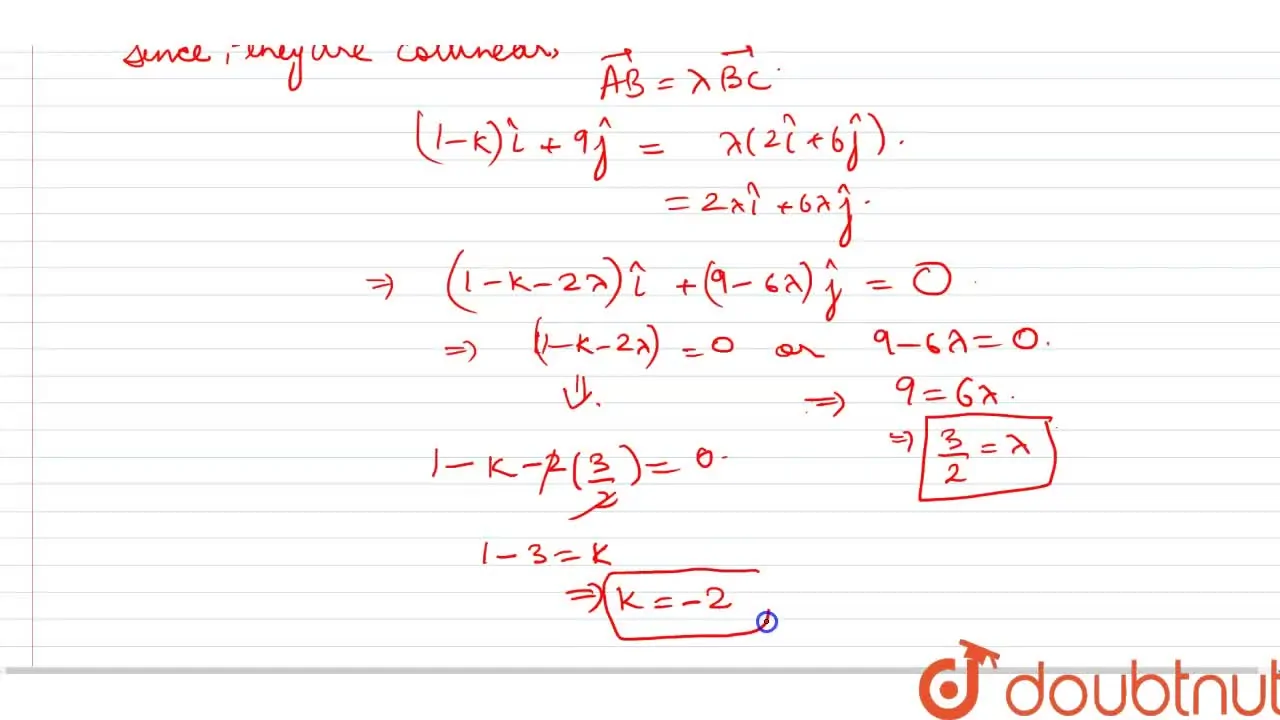Using vectors, find the value of k, such that the points (k,-10, 3), (1,-1, 3) and (3, 5, 3) are collinear.
The correct Answer is:
Let the points are A(k, -10, 3), B(1,-1, 3) and C(3, 5, 3).
So −−→AB=−−→OB−−−→OA
=(ˆi−ˆj+3ˆk)−(kˆi−10ˆj+3ˆk)
=(1−k)ˆi+(−1+10)ˆj+(3−3)ˆk
=(1−k)ˆi+9ˆj+0ˆk
∴∣∣∣−−→AB∣∣∣=√(1−k)2+(9)2+0=√(1−ˆk)2+81
Similarly, −−→BC=−−→OC−−−→OB
=(3ˆi+5ˆj+3ˆk)−(ˆi−ˆj+3ˆk)
=2ˆi+6ˆj+0ˆk
∴∣∣∣−−→BC∣∣∣=√22+62+0=2√10
and −−→AC=−−→OC−−−→OA
=(3ˆi+5ˆj+3ˆk)−(kˆi−10ˆj+3ˆk) =(3−k)ˆi+15ˆj+0ˆk
∴∣∣∣−−→AC∣∣∣=√(3−k)2+225
If A, B and C are collinear, then sum of modulus of any two vectors will be equal to the modulus of thridn vectors
For ∣∣∣−−→AB∣∣∣+∣∣∣−−→BC∣∣∣=∣∣∣−−→AC∣∣∣
⇒√(1−k)2+81+2√10=√(3−k)2+225
√(3−k)2+225−√(1−k)2+81=2√10
⇒√9+k2−6k+225−√1+k2−2k+81=2√10
⇒√k2−6k+234−2√10=√k2−2k+82
⇒k2−6k+234+40−2√k2−6k+234.2√10=k2−2k+82
⇒k2−6k+234+40−k2+2k−82=4√10√k2+234−6k
⇒−4k+192=4√10√k2+234−6k
⇒−k+48=√10√k2+234−6k
On squaring both sides, we get
48×48+k2−96k=10(k2+234−6k)
⇒k2−96k−10k2+60k=−48×48+2340
⇒−9k2−36k=−48×48+2340
⇒(k2+4k)=+16×16×−260 [dividing by 9 in both sides]
⇒k2+4k=−4
k2+4k+4=0
⇒(k+2)2=0
∴k=−2

Let the points are A(k, -10, 3), B(1,-1, 3) and C(3, 5, 3).
So −−→AB=−−→OB−−−→OA
=(ˆi−ˆj+3ˆk)−(kˆi−10ˆj+3ˆk)
=(1−k)ˆi+(−1+10)ˆj+(3−3)ˆk
=(1−k)ˆi+9ˆj+0ˆk
∴∣∣∣−−→AB∣∣∣=√(1−k)2+(9)2+0=√(1−ˆk)2+81
Similarly, −−→BC=−−→OC−−−→OB
=(3ˆi+5ˆj+3ˆk)−(ˆi−ˆj+3ˆk)
=2ˆi+6ˆj+0ˆk
∴∣∣∣−−→BC∣∣∣=√22+62+0=2√10
and −−→AC=−−→OC−−−→OA
=(3ˆi+5ˆj+3ˆk)−(kˆi−10ˆj+3ˆk) =(3−k)ˆi+15ˆj+0ˆk
∴∣∣∣−−→AC∣∣∣=√(3−k)2+225
If A, B and C are collinear, then sum of modulus of any two vectors will be equal to the modulus of thridn vectors
For ∣∣∣−−→AB∣∣∣+∣∣∣−−→BC∣∣∣=∣∣∣−−→AC∣∣∣
⇒√(1−k)2+81+2√10=√(3−k)2+225
√(3−k)2+225−√(1−k)2+81=2√10
⇒√9+k2−6k+225−√1+k2−2k+81=2√10
⇒√k2−6k+234−2√10=√k2−2k+82
⇒k2−6k+234+40−2√k2−6k+234.2√10=k2−2k+82
⇒k2−6k+234+40−k2+2k−82=4√10√k2+234−6k
⇒−4k+192=4√10√k2+234−6k
⇒−k+48=√10√k2+234−6k
On squaring both sides, we get
48×48+k2−96k=10(k2+234−6k)
⇒k2−96k−10k2+60k=−48×48+2340
⇒−9k2−36k=−48×48+2340
⇒(k2+4k)=+16×16×−260 [dividing by 9 in both sides]
⇒k2+4k=−4
k2+4k+4=0
⇒(k+2)2=0
∴k=−2
Related Playlists
Similar Questions
Using vectors, find the value of λ such that the points (λ,−10,3),(1,−1,3)and(3,5,3) are collinear.
View SolutionUsing vectors find the value of λ such that the points (λ,−10,3),(1,−1,3)and(3,5,3) are collinear
View SolutionFind the value of k for which the points A(-1, 3), B(2, k) and C(5, -1) are collinear.
View SolutionUsing slopes show that the points (1,3), (3,-1) and (5,-5) are collinear.
View SolutionFind the value of k for which the points A(k+1, 2k), B(3k, 2k +3) and C(5k-1, 5k) are collinear.
View SolutionFind the value of k in order that the points (5, 5), (k, 1) and (10, 7) are collinear.
View SolutionFind the value of k for which the points A(-2, 3), B(1, 2) and C(k, 0) are collinear.
View SolutionFind the values of k, if the points A (k+1,2k) ,B (3k,2k+3) and C (5k-1,5k) are collinear.
View SolutionFind the value of λ or which the points A(2,5,1) ,B(1,2,-1) and C(3,λ,3) are collinear .
View SolutionIf the points (-3,4), (-14,12) and (8,k) are collinear then :k
View Solution


